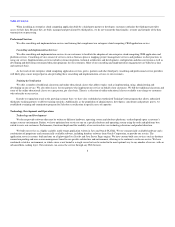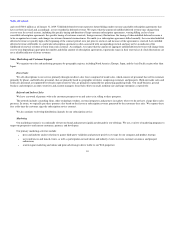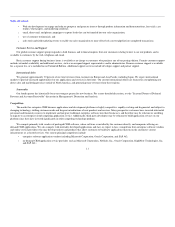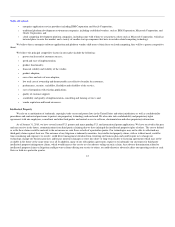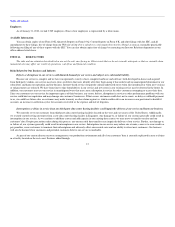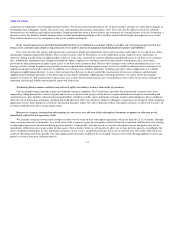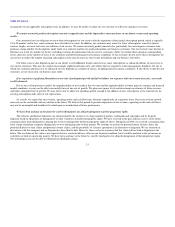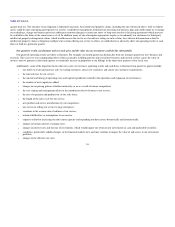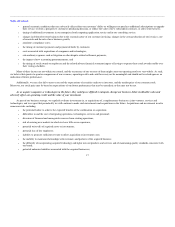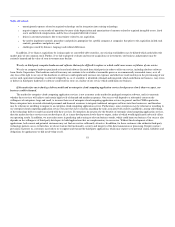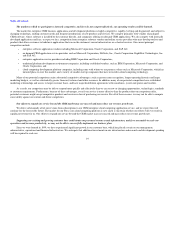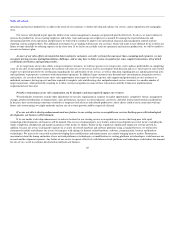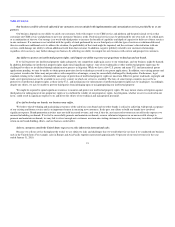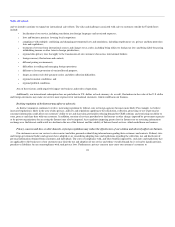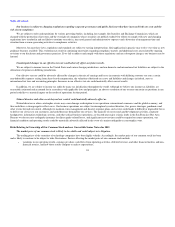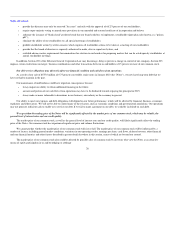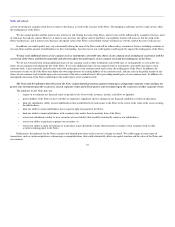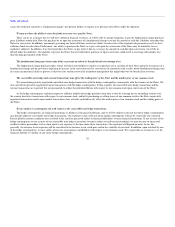Salesforce.com 2009 Annual Report Download - page 21
Download and view the complete annual report
Please find page 21 of the 2009 Salesforce.com annual report below. You can navigate through the pages in the report by either clicking on the pages listed below, or by using the keyword search tool below to find specific information within the annual report.
Table of Contents
• unanticipated expenses related to acquired technology and its integration into existing technology;
• negative impact to our results of operations because of the depreciation and amortization of amounts related to acquired intangible assets, fixed
assets and deferred compensation, and the loss of acquired deferred revenue;
• delays in customer purchases due to uncertainty related to any acquisition;
• the need to implement controls, procedures and policies appropriate for a public company at companies that prior to the acquisition lacked such
controls, procedures and policies; and
• challenges caused by distance, language and cultural differences.
In addition, if we finance acquisitions by issuing equity or convertible debt securities, our existing stockholders may be diluted which could affect the
market price of our common stock. Further, if we fail to properly evaluate and execute acquisitions or investments, our business and prospects may be
seriously harmed and the value of your investment may decline.
We rely on third-party computer hardware and software that may be difficult to replace or which could cause errors or failures of our service.
We rely on computer hardware purchased or leased and software licensed from third parties in order to offer our service, including database software
from Oracle Corporation. This hardware and software may not continue to be available at reasonable prices or on commercially reasonable terms, or at all.
Any loss of the right to use any of this hardware or software could significantly increase our expenses and otherwise result in delays in the provisioning of our
service until equivalent technology is either developed by us, or, if available, is identified, obtained and integrated, which could harm our business. Any errors
or defects in third-party hardware or software could result in errors or a failure of our service which could harm our business.
If the market for our technology delivery model and an enterprise cloud computing application service develops more slowly than we expect, our
business could be harmed.
The market for enterprise cloud computing application services is not as mature as the market for packaged enterprise software, and it is uncertain
whether these services will achieve and sustain high levels of demand and market acceptance. Our success will depend to a substantial extent on the
willingness of enterprises, large and small, to increase their use of enterprise cloud computing application services in general, and for CRM in particular.
Many enterprises have invested substantial personnel and financial resources to integrate traditional enterprise software into their businesses, and therefore
may be reluctant or unwilling to migrate to an enterprise cloud computing application service. Furthermore, some enterprises may be reluctant or unwilling to
use enterprise cloud computing application services because they have concerns regarding the risks associated with security capabilities, among other things,
of the technology delivery model associated with these services. If enterprises do not perceive the benefits of enterprise cloud computing application services,
then the market for these services may not develop at all, or it may develop more slowly than we expect, either of which would significantly adversely affect
our operating results. In addition, we may make errors in predicting and reacting to relevant business trends, which could harm our business. Our success also
depends on the willingness of third-party developers to build applications that are complementary to our service. Without the development of these
applications, both current and potential customers may not find our service sufficiently attractive. In addition, for those customers who authorize third-party
technology partners access to their data, we do not warrant the functionality, security and integrity of the data transmission or processing. Despite contract
provisions to protect us, customers may look to us to support and warrant the third-party applications, which may expose us to potential claims, liabilities and
obligations for applications we did not develop or sell.
18


